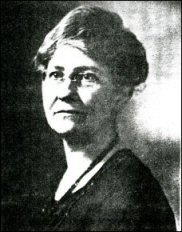|
 |
|
 |
Wednesday, July 21, 1948
And how they contribute their share in the beauty of our country-sides. Clear, sweet, pure, flowing along on a bed of shiny pebbles. Who does not desire, when beholding the charms of a little brook, to strip off shoes and stockings and wade its entire length? Little children always do that and fortunate is the child who grew up beside a stream. Alders bend beside its gentle music and trout hide in their shade.
We have many streams in our town—some tiny, some large—but all of them safely buried in the memories of sons and daughters of Parishville who have wandered far from its hills and streams. Out on the Hopkinton is one, and many are the trout caught in its quiet waters by young an old, some of whom treasure its beauties as long as life shall last.
Then there is Alder Meadow Brook, now placarded by the State as a "Creek." The late Miss Eva Clapp resented the new appellation as detracting from its ancient beauty. At any rate it gets quite high in the Spring, but gradually goes down, and happy is the fisherman who "angles" along its bank up into Picketville and on to its source. It flows into the St. Regis below Hotalings.
Barton Brook is beloved, too, by fishermen. Near Potsdam is the Parkhurst Brook, with many shaded pools deep enough for small swimmers. In the west part of the town, crossing the old Lonnie Thomas farm, is a lovely stream, wide and deep enough for cattle to wade and drink in. At sunset, the water reflecting its surroundings makes a picture worthy of any artist. And so the little streams were placed all over St. Lawrence County, perhaps as an offset against the ice and snow which hide them all winter. Even then, the true nature lover, listening, can hear their sweet voices murmuring beneath the wrappings which envelop them.
All these help to swell the waters of our rivers, four of them flowing in the same direction, almost side by side into the noble stream which is our northern boundary. Rising in the hoary Adirondacks, their waters are clear, sweet and sometimes swift as they flow over rocks in their beds. The Racquette is the largest of the four. In days gone by its power drove the wheels of many a mill and conveyed millions of logs on its breast. Whoever lived near its banks will remember always the "drive" as it came down from the forest, through the towns, through the farmlands at last to its destination, a big saw mill.
The "river-drivers" would halt in the village for a possible spree, preparing their meals down by the river-bank, frying salt pork, or tossing delectable pancakes. It was really something to watch a skillful river-driver break a jam on the falls as hundreds of logs became piled up on the jagged rocks. Sometimes he would pry at the logs for hours before some gave way and the great pile began slowly to move over the falls down-stream. He must be lively, indeed, to make shore before being carried over himself. These men were brave, fearless, hardy and picturesque. It seems as though the rivers were higher and rougher long ago. The Racquette rises in a lake of the same name, deep in the forest.
Our own river rises near Paul Smiths' in St. Regis Lake. The Oswegatchie rises in Cranberry Lake and flows into the St. Lawrence where Father Picquet discovered it and the future site of Odgensburg 200 years ago. Its black waters may be seen far out in the lovely turquoise waters of the big river. The Grass has its origin not very far from Cranberry in a small lake made by its own enlargement at that point. The St. Regis and Grass each have branches, each one a sizable river.
In pioneer days they all contributed to the enterprises and means of communication of the settlers. In winter they could travel on the ice, in summer in boats. Their waters furnished delicious food, as fish were very numerous and of various kinds. Their water power started unnumbered mills, and not a few fortunes flowed from their rushing torrents. When pleasure seekers finally learned of the sports to be enjoyed on the banks of Adirondack rivers and lakes, they came in ever increasing numbers to pitch their tents where the deer quenched their thirst at night and where the weird note of the loon breathed of restful silences and pure air, deep in the woods and far from the noisy cities.
But the river-driver rides the big logs no more. Few saw-mills make their music in Adirondack villages. The city man's tents, his boats, his "jack-hunting" are but memories. When he comes, it is in a rush of whirring rubber and an emission of carbon monoxide. The real pleasures of the Big Woods were found in a tent; not in a huge hotel already full of hustling travelers. Lying under the stars on a bed of pine needles one saw the map of the heavens—and marveled.
|